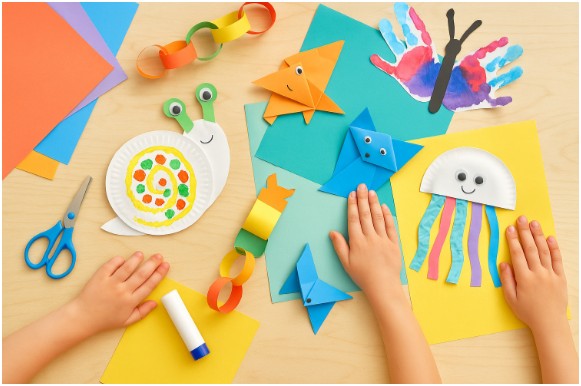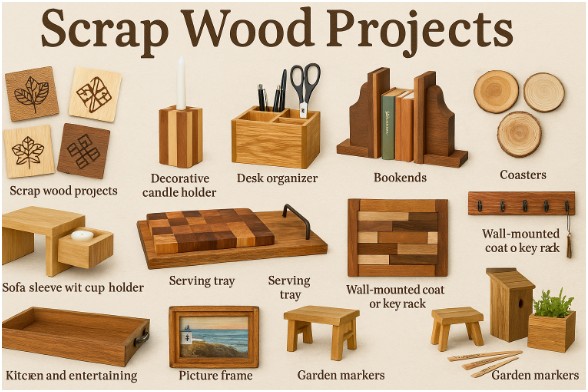I still remember the first time I handed my niece a stack of colorful paper, glue, and some safety scissors. Within minutes, our dining table turned into a creative explosion—paper butterflies, wobbly snakes, and glitter-covered “masterpieces.”
That day reminded me how magical paper crafts for kids can be. You don’t need fancy materials or endless supplies—just imagination, a bit of patience, and maybe a paper plate or two.
Paper crafts are more than just fun; they’re creative, budget-friendly, and perfect for rainy days or lazy weekends. Whether your little one is a toddler or a budding artist, there’s always something new to make. Here’s my personal guide to keeping kids busy, curious, and happy with paper crafts!
What Makes Paper Crafts for Kids So Special?
Paper crafts blend creativity, motor skills, and storytelling in a way few activities can. Kids learn to fold, cut, glue, and color—all while creating something they can proudly display.
What I love most is how flexible these crafts are. A single paper plate can become a snail, a jellyfish, or even a butterfly depending on the child’s imagination.
Plus, it’s eco-friendly. You can reuse everyday items like toilet paper rolls, old magazines, and leftover wrapping paper. There’s no pressure to be perfect—just the joy of creating something together.
What Are the Easiest Paper Crafts for Kids to Start With?
When kids are just beginning, simplicity is key. I like starting with crafts that don’t involve too much cutting or detail work. For toddlers, glue, paint, and cotton balls are enough to create something adorable.
Paper Plate Snails are a favorite at my house. Just cut a spiral from a paper plate, dab it with colorful paint, and glue on a pair of googly eyes. It’s an instant smile-maker.
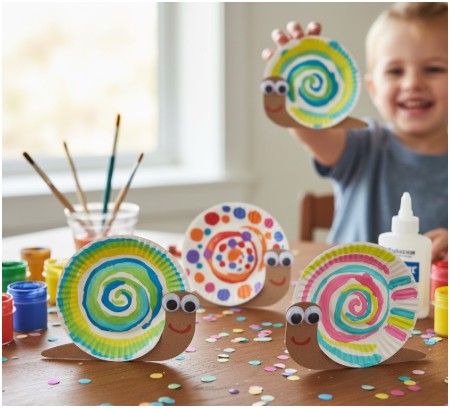
Handprint Butterflies are another gem—kids love turning their painted palms into fluttering wings.
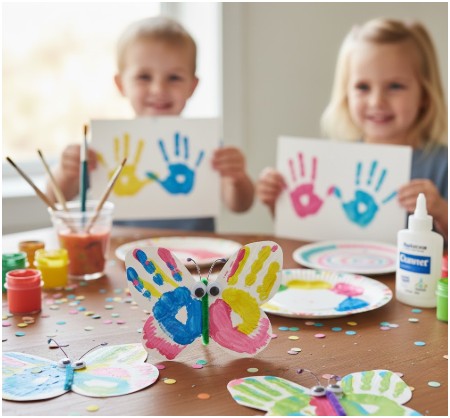
If your child enjoys patterns, try a Rainbow Mosaic. Cut construction paper into small squares and let them glue the colors across a printed rainbow. It’s perfect for color learning and sensory play.
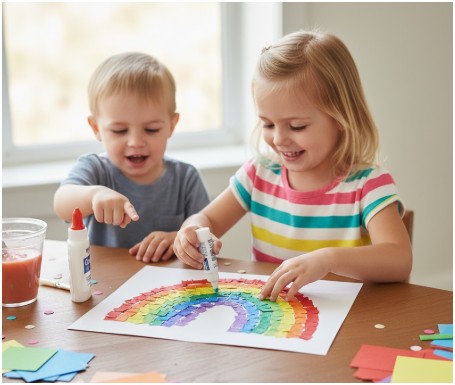
How Can School-Age Kids Try More Creative Paper Crafts?
Once kids master basic crafts, they’re ready for projects that involve folding, shaping, or layering. These are great for ages 5–10, when they crave a little challenge.
One of my go-to crafts is the Paper Chain Snake. It’s a simple concept—link colorful paper loops together—but kids can stretch their imagination with patterns, lengths, and silly faces.
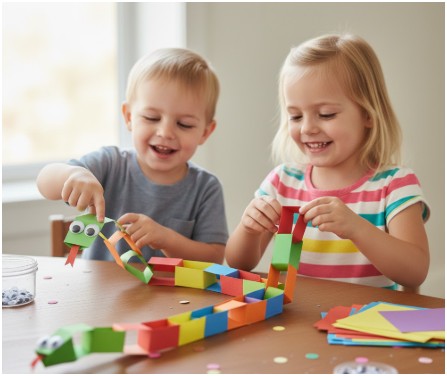
If your child loves puzzles or precision, Origami Animals are a hit. Frogs that hop, peacocks with fanned feathers, or cute little fish—all from a square of paper!
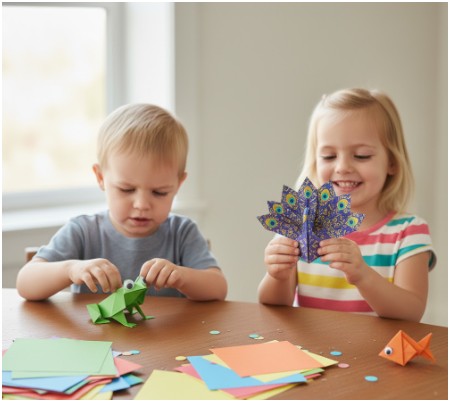
For extra excitement, printable 3D Paper Models like houses or cars introduce kids to building concepts without feeling like “learning.”
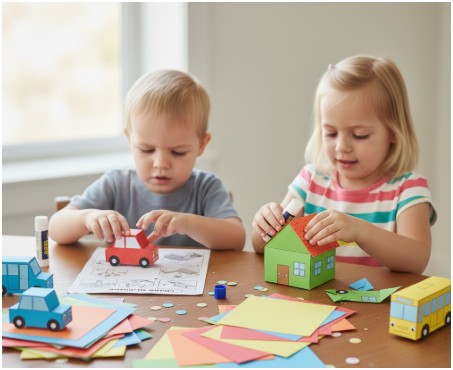
And for the holidays? Paper Snowflakes always make a comeback. There’s something magical about unfolding a piece of paper to reveal a surprise pattern inside.
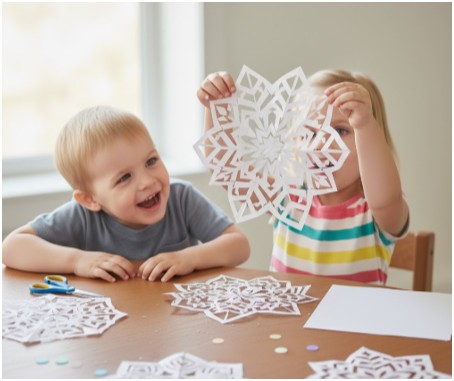
Are There Paper Craft Kits That Make Things Easier?
If you’d rather skip the prep work, craft kits are a game-changer. They come with all the supplies, templates, and easy-to-follow guides—no more searching for glue sticks under the couch.
Here’s a quick comparison of some of my favorites:
| Craft Kit | Recommended Age | Highlights | Price Range (USD) |
| Skillmatics Snip Snip Amazing Animals Book | 3–7 years | Teaches cutting safely with 25 activities | $6–$7 |
| DIY Celebration Kit (Imagimake) | 5–12 years | 25+ projects, 500+ supplies | $20–$22 |
| Quill On Paper Quilling Kit | 7+ years | Motorized tool for quilling | $5–$10 |
| Fevicreate Tissue Art Kit | 5+ years | 5 templates, 8 tissue colors | $4–$5 |
| BeginBird Sticker by Number Set | 5+ years | Mosaic-style sticker art | $8–$9 |
I’ve tried a few of these during school breaks, and the kids loved how independent they felt following the step-by-step instructions. Plus, these kits make wonderful gifts that keep on giving—long after the batteries in new toys die out.
What Paper Craft Books Are Worth Keeping at Home?
Books are perfect for screen-free afternoons. When kids can flip pages and pick a project themselves, it sparks ownership in their creativity.
Paper Crafts for Kids by Stefania Luca is one of my top picks—it includes 25 projects like origami cats and clothespin puppets, all with ready-to-cut templates. For older children, Make Your Own Paper Figures – Racing Cars turns paper into high-speed fun.
If you’re looking for variety, 3D Paper Crafts for Kids by Helen Drew offers 26 alphabet-based projects (A for airplane, B for bird, and so on). And for families who love games, Origami Games by Joel Stern shows kids how to fold and play their own creations.
How to Make Paper Crafts for Kids More Fun and Mess-Free
I’ve learned that kids’ excitement can sometimes lead to creative chaos. To keep crafting stress-free, I set up a “craft corner” with washable mats, wipes, and an old apron for everyone involved.
Encourage kids to pick their own paper colors and decorations—this boosts confidence. You can even introduce “craft themes” like jungle animals one week and under-the-sea creatures the next.
When it comes to glue, less is more. For toddlers, glue sticks are easier to control. For older kids, craft glue bottles let them explore textures and layering. And if you’re crafting on a sunny day, let the finished pieces dry by the window—sunlight brings those colors alive!
Frequently Asked Questions About Paper Crafts for Kids
1. What are the benefits of paper crafts for kids?
Paper crafting helps kids develop fine motor skills, problem-solving, and creativity. It also teaches patience and focus—especially in projects that require folding or layering. It’s hands-on fun that doubles as learning time.
2. How can I encourage my child if they get frustrated?
Start small and focus on effort, not perfection. I often remind kids that every creation is unique—there’s no “right” way to make a butterfly or a snake. Celebrate their imagination, not the outcome.
3. Are paper crafts suitable for group activities?
Absolutely! They’re perfect for classrooms, playdates, or birthday parties. You can set up stations—folding, cutting, decorating—and let kids rotate through. It keeps everyone engaged and minimizes waiting time.
4. What’s the best way to store finished crafts?
Use a scrapbook or a hanging string display. It’s a beautiful way to showcase their progress and creativity over time. For larger crafts, like paper plate animals, a cardboard box labeled “Art Time” works wonders.
Craft, Laugh, Repeat – Because Paper Makes Magic
Every time I sit down with kids to create something from paper, I’m reminded that art isn’t about the outcome—it’s about connection. These projects are opportunities to laugh, talk, and make small moments memorable.
So the next time your child says “I’m bored,” hand them some paper, a pair of scissors, and an idea. Who knows? You might just discover a little artist right at your kitchen table.
Because when it comes to paper crafts for kids, the joy isn’t in perfection—it’s in the mess, the smiles, and the stories you create together.

